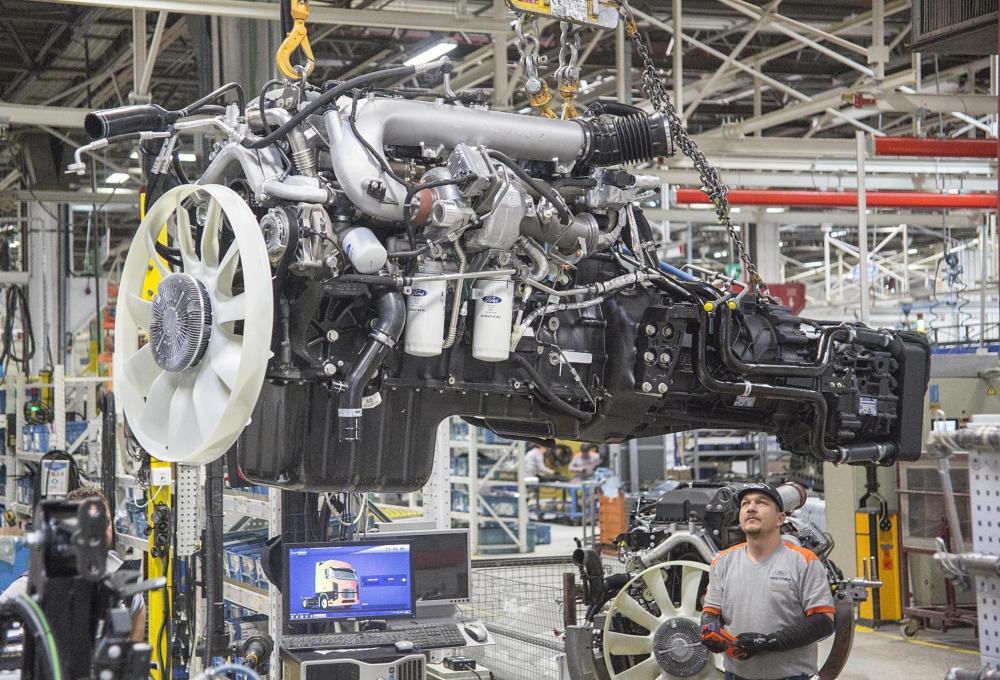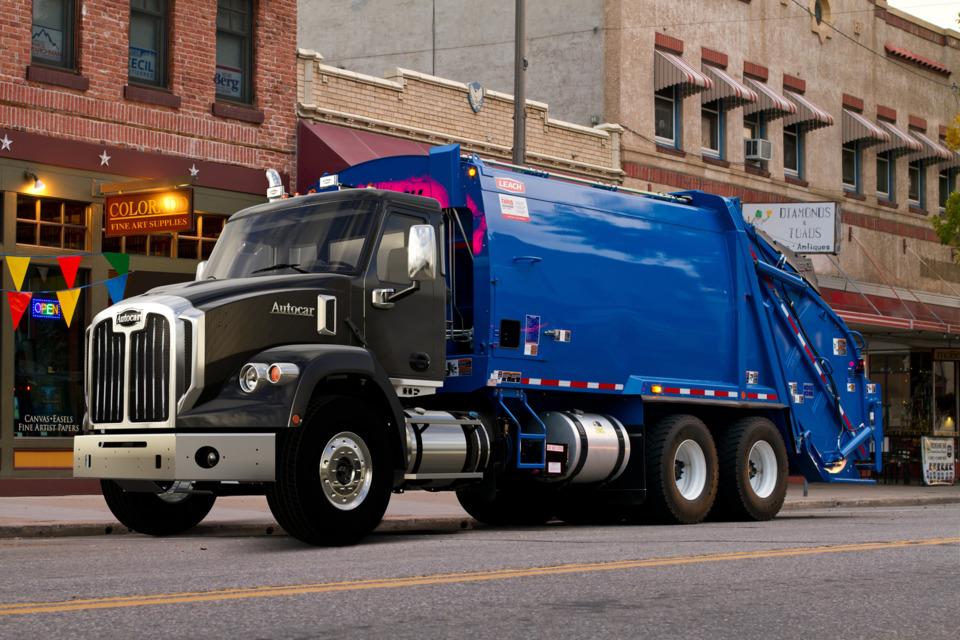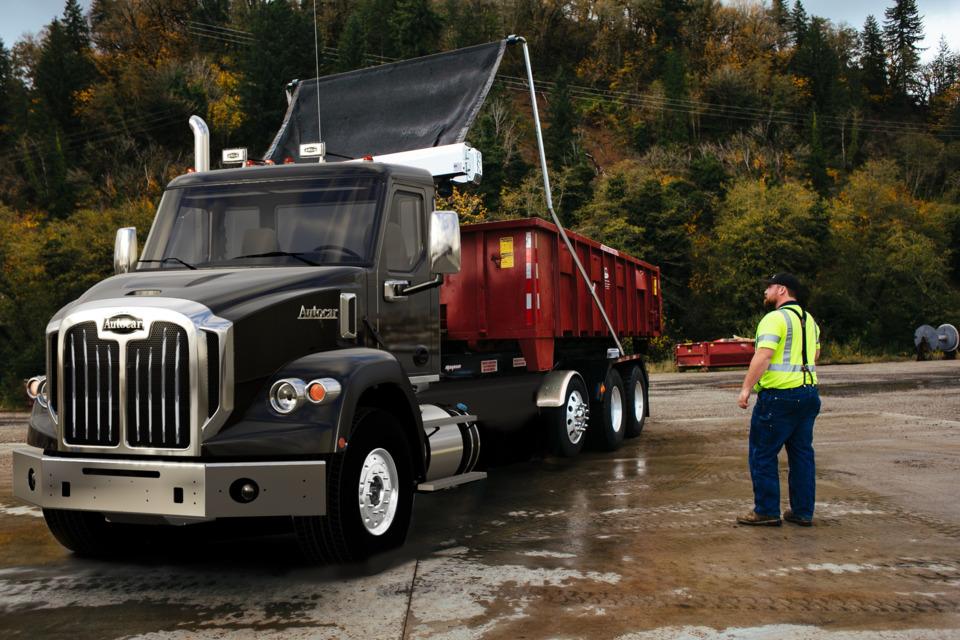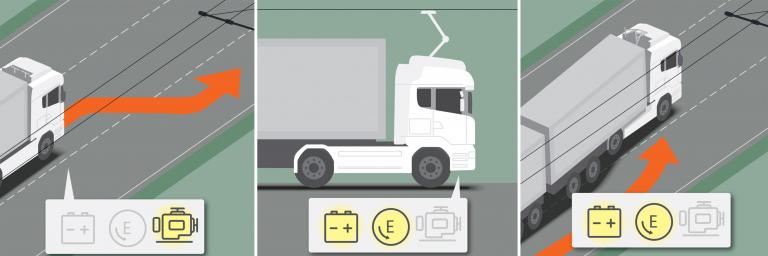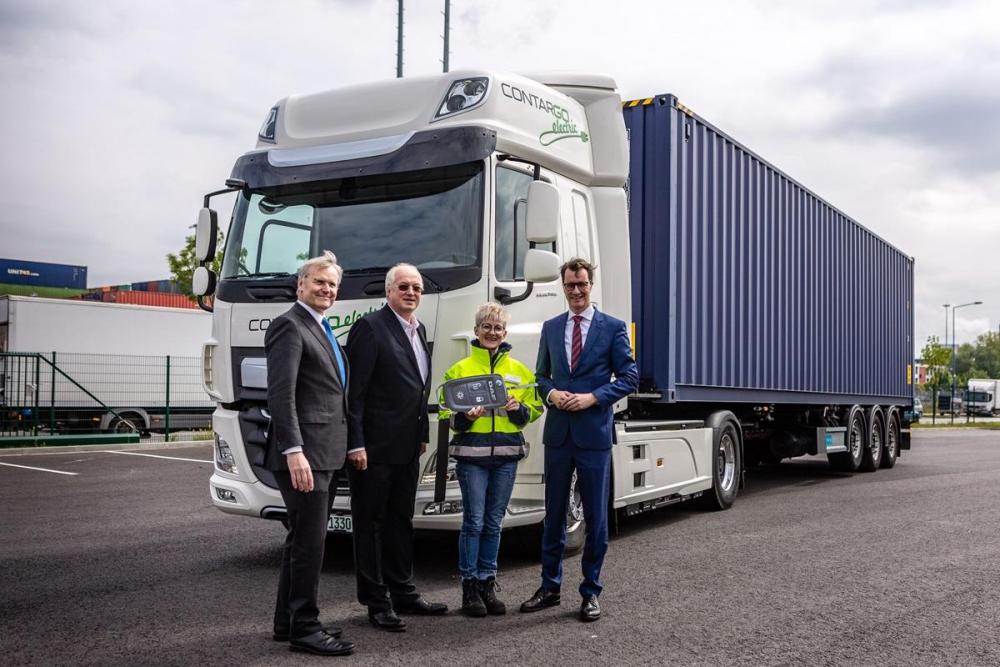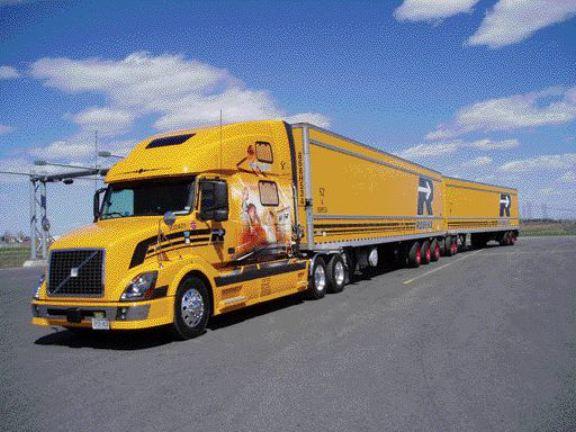
kscarbel2
Moderator-
Posts
18,855 -
Joined
-
Days Won
114
Content Type
Profiles
Forums
Gallery
Events
Blogs
BMT Wiki
Collections
Store
Everything posted by kscarbel2
-
Ford Trucks International / May 7, 2019 Boost your strength with the 500 PS/2500 Nm Ecotorq engine, the heart of the Ford Trucks F-MAX: superior performance that you can feel behind the wheel. .
-
Autocar Rolls out New Conventional Truck Model Heavy Duty Trucking (HDT) / April 7, 2019 America’s self-proclaimed oldest truck builder has a new conventional model hitting the market. The Autocar DC-64R is a completely new conventional truck purpose-built from the ground-up for severe-duty refuse applications, according to the OEM. The company added that the new truck features several innovations that make it especially suited to refuse-hauling applications. “The DC-64R is the direct result of the requests, insights, data, and guidance we received from many waste haulers across the industry,” said Autocar President James Johnston. "We could not have engineered a truck this good without all their feedback that resulted in innumerable improvements. We’re grateful for their help and proud to bring to this market a truck that is honestly customer-built.” The DC model’s cab is totally new and was designed by Autocar for productivity, durability and safety in the refuse industry. “The workspace of the cab maximizes productivity for drivers,” explained Managing Director Eric Schwartz. “From the biggest guys to petite women, with everything visible and within easy reach. The cab also easily fits three, so work crews can get to and from their routes comfortably. Our raked windshield provides exceptional visibility for safety. And the interior uses authentic materials like a full steel structure inside the dashboard and aluminum sheets as dash panels. Even the interior door handles are aluminum tubes, not plastic. The totally new cab structure is built from a combination of steel, judiciously chosen aluminum components, and corner castings to withstand years of refuse abuse.” Autocar said the DC-64R is the first truck ever built to feature frame rails made from ultra-high-strength 160,000 PSI steel, which the company said is 24% stronger and lighter than the rails on other trucks on the market and completely eliminates the need for frame liners in nearly all refuse applications. The primary benefit for the waste hauler is a significant weight savings that directly increases effective payload – and therefore, profitability. “One of the things we’re proudest of is our totally upgraded electric system to resist the worst the garbage business can dish out," Johnston said. “The DC also brings our customers the Autocar Always Up display, with one-touch diagnostics. It actually tells the operator or technician what fault has occurred and shows them how to fix it.” The DC-64R is the first new conventional truck for the Autocar brand in 31 years. It joins the ACX and ACMD cabover trucks and the ACTT terminal tractor, as the OEM’s fourth in its model lineup. The new truck also represents the rebirth of Autocar’s DC, first introduced by The Autocar Company in 1939 as its premier severe-duty, diesel-powered work truck. The DC is also the first of Autocar’s lines to carry the recently announced Autocar bowtie logo, reborn on its 100th birthday. Autocar was created in 1899, just one year after the Winton Motor Vehicle Co. built the first truck in North America. Over the years, Autocar was a key player in the trucking industry and introduced numerous innovations. It changed owners a number of times before being acquired by Volvo in 1981 as part of the acquisition of White Motor. In 2001, Autocar became a subsidiary of Grand Vehicle Works Holdings LLC of Union City, Indiana, after Volvo Trucks North America spun it off. Volvo was required to sell its low-COE truck business as part of the deal to acquire Mack Trucks/Renault RVI.
-
Autocar Trucks launches DC-64R "Always Up" conventional truck Autocar / May 7, 2019 The Autocar DC-64R is a conventional truck that is suited for refuse-hauling. Autocar Trucks announces the launch of the Autocar DC-64R, a conventional truck for severe-duty refuse applications. Autocar’s guiding mission is to build trucks to be “Always Up”, that is, to stay in service despite the challenges of severe-duty applications. The Autocar DC-64R (the R stands for refuse) is suited for refuse-hauling. James Johnston, president, Autocar, said “The DC-64R is the direct result of the requests, insights, data, and guidance we received from many waste haulers across the industry. We could not have engineered a truck this good without all their feedback that resulted in innumerable improvements. We’re grateful for their help and proud to bring to this market a truck that is honestly customer-built.” Eric Schwartz, managing director, Autocar Trucks, said “The DC’s cab is totally new and was designed by Autocar from the beginning for exceptional productivity, durability -- and especially safety -- in the refuse industry. The workspace of the cab maximizes productivity for drivers… with everything visible and within easy reach. The cab also easily fits three, so work crews can get to and from their routes comfortably. Our unique raked windshield provides exceptional visibility for safety. And, true to our Always Up mission and Autocar’s legendary toughness, the interior uses authentic materials like a full steel structure inside the dashboard and aluminum sheets as dash panels. Even the interior door handles are aluminum tubes, not plastic. The totally new cab structure is built from a combination of steel, judiciously chosen aluminum components, and corner castings to withstand years of refuse abuse.” According to the company, the Autocar DC-64R is the first truck ever built to feature 160,000 PSI steel frame rails. The primary benefit for this waste hauler is a significant weight savings that directly increases effective payload. Johnston continued, “One of the things we’re most proud of – because it will make a big difference in our customers’ business – is our totally upgraded electric system to resist the worst the garbage business can dish out. The DC also brings our customers the Autocar Always Up display, with game-changing ‘one-touch diagnostics’. It actually tells the operator or technician what fault has occurred and shows them how to fix it. It gets trucks back into service and making money faster than anything anyone has had before.” Schwartz added, “Everything about this truck is designed to solve problems our customers have with other trucks and achieve our goal of Always Up. There are so many other innovations, from the engines up to 500 HP that are hundreds of pounds lighter, to a real breakthrough in body integration. This truck is just revolutionary in the ways it will help waste haulers serve their customers and create ROI.” The company revealed it has already accepted firm orders for production of the DC-64R at its Birmingham, Alabama factory, starting at the end of this summer. According to the company, the DC-64R is the first conventional truck for the Autocar brand in 31 years, and it joins the ACX and ACMD cabover trucks, and the ACTT terminal tractor, as Autocar’s fourth line. The truck also represents the rebirth of Autocar’s DC, first introduced by The Autocar Company in 1939, as its severe-duty and diesel-powered work truck. The DC is also the first of Autocar’s lines to carry the Autocar bowtie logo, reborn on its 100th birthday. Johnston commented, “We’ve gone back to Autocar’s roots with the logo... It’s the perfect time to show that we are inspired by the best of our history to build something fantastic for the future.” .
-
Well first of all, truth be told, Dirtymilkman (Mark) who spends all his time jet setting around the world has never set foot in his MP10 Titan. Heir to the Marriott fortune, he has never worked a day in his life. As for MPG, if you had a driver and his exact clone operating two identical trucks under the same operating conditions under 80,000lb, the X12 would prove more economical than the X15.
-
Bob, following the global standard, that's a 32 metric ton bogie (70,548lb). I believe Ford does produce those in-house in Turkey. Before creating it's own proprietary unit, Ford was using the 32-ton Meritor MT32-610* planetary hub reduction axle on its vocational range. In China, for JMC production, they use planetary hub reduction axles produced by Fuwa. * https://www.meritor.com/-/media/Meritor/Products/sidebar-download-icons/SP18117-Axles-Europe.ashx?la=en&hash=130FEA292C5C0E074CAD522B233094C4 http://meritor-aftermarket.eu/catalogues/MC1404_Meritor_MT160_Hub Reduction_Web2.pdf
-
The truck we see here is obviously a short-nose set up for the X12. But if they've thought this through, there likely is a longer nose Autocar vocational engineered for the X15, for both dump and heavy-haul tractor applications. Only a fool would ignore that segment.
-
Paccar's huge mistake in the making is NOT offering the X12. Paccar was offering the ISX12. But that model has now been replaced with the X12, and Paccar refused to sign a purchase agreement with Cummins for the X12. So now, Paccar customers have no more "choice". It's the DAF-designed Paccar MX engine.....or nothing. Americans (and Australians) like "choice". I am seeing some T880 dumps with X15s, but c'mon, that's ridiculous overkill. The X12 would offer abundant power (350-500hp) with far better fuel economy.
-
Volvo Group Press Release / May 6, 2019 .
-
Scania Group Press Release / May 7, 2019 Zero carbon footprint, quieter vehicles, good driveability and no exhaust emissions. Continuous charging along electric roads has huge potential for heavy transport. On a busy highway, a truck with trailer is approaching a long section with pylons on the right side. The vehicle’s sensor detects that the traffic lane is now equipped with an electric contact line, and the driver pushes a button to raise a pantograph fitted on the cab’s roof. Within seconds, the cab turns almost completely silent: the combustion engine has stopped, and the electrical motor now powers the vehicle. A clean, safe and efficient technology Just a few years ago the thought that electrically-powered long haulage trucks could co-exist with passenger cars on ordinary highways would have been a vision of the future. But today, several projects are ongoing in Europe to test and evaluate this clean, safe and efficient technology. Governments and authorities in Germany, Italy and Sweden are actively supporting research projects, with the ultimate aim of building an electrification infrastructure that could cover parts of the highway network in Europe with this green technology. “Vehicle electrification is developing quickly” Scania’s view is that it will not be very long until the tipping point is reached where electrification for heavy transport will become a sound investment for transport operators. But as the company continues to invest in and develop electrified solutions, Scania is also pursuing other and more immediate paths to reach sustainable transport. Claes Erixon, Scania’s Executive Vice President Research and Development, says the company sees electric roads as one of several promising technologies that can make long-haul transport a sustainable future. “Vehicle electrification is developing quickly and with its environmental, social and cost benefits, it will play an important role in the shift to a fossil-free transport system,” he says. This is how it works: 1. Finding the eHighway A sensor checks whether the traffic lane is equipped with a contact line. Until now the truck has been powered by the combustion engine. Now, the driver raises the pantograph. 2. Connects to the contact line When connected, the pantograph transfers the energy directly to the electric motor, simultaneously charging the battery. During braking, electricity is generated as the flow of energy is reversed, charging the on-board battery. 3. Disconnects when overtaking When the truck is overtaking or is at the end of an electrified section, the pantograph lowers itself. The electrical motor continues to run on battery power for as long as possible. After overtaking the driver can return to the eHighway.
-
DAF Trucks Press Release / May 6, 2019 DAF Trucks has delivered two fully electric trucks to Contargo in Germany. Contargo is a 100% subsidiary of the leading international Rhenus Group. The DAF CF Electric featuring E-Power Technology from VDL is used for container transport around hinterland terminals in the German Lower Rhine area. The two trucks delivered to Contargo are the first DAFs CF Electric that are put into operation in Germany, and the 6th and 7th to take part in an extensive field test. Richard Zink, Director Marketing & Sales and Member of the Board of Management at DAF Trucks, handed over the key of the CF Electric to Michael Viefers, Member of the Board of the Rhenus Group. Rhenus Group is a global logistics service company, specialized in Contract Logistics, Freight Logistics and Port Logistics. It has a turnover of € 4.8 billion, more than 610 locations worldwide and employs 29,000 people. The two CF Electric trucks join the fleet of the trimodal container hinterland specialist Contargo, a 100% Rhenus company, handling a total volume of 2 million containers per year. Electric trucks for urban areas “It is clear that the transport sector is on the cusp of a major transformation”, states Richard Zink. “Take the better route is Contargo’s aim and I am extremely proud that we can support this mission and drive the success of Contargo even further with two DAF CF Electric trucks. They are ‘the better route’ as the electric truck is set to become the norm in more and more urban areas in future, all around Europe.” Zink continues: “We are delighted we can broaden our experience with electric trucks in collaboration with renowned companies like Rhenus. The data we collect about both the technology and the operational deployment will feed into the specifications for the final production models, thus ensuring that they fit seamlessly with the requirements of the market.” “Important step towards de-carbonization” “We are very proud to be one of the first to drive these pioneering DAFs”, states Jürgen Albersmann, Managing Director at Contargo. “One of our targets is to be de-carbonized by 2050. These trucks represent one important step towards this ambitious target.” Local container delivery The DAF CF Electric trucks will have their home base in Duisburg and will be used for local container deliveries within the conventional truck fleet of Contargo. The management of the truck will be executed by Rhenus Trucking, acting as service provider for Contargo. About the DAF CF Electric The DAF CF Electric is a full electric 4x2 tractor unit developed for road haulage of up to 37 tonnes in urban areas, where single-axle or dual-axle trailers are the norm. The vehicle is based on the DAF CF — named 'International Truck of the Year 2018' — and is operated fully electrically using VDL's E-Power Technology. The core of its intelligent powertrain is a 210-kW electric motor powered by a lithium-ion battery pack with a current total capacity of 170 kWh. The CF Electric has a range of up to 100 kilometres, depending on the weight of its cargo, making it suitable for zero emissions high-volume transport in the urban areas. The batteries have a 30-minute quick-charge feature and a full charge takes just one and a half hours. DAF CF Electric - Technical specifications Truck weight 9,700 kg Electric motor 210 kW Torque 2,000 Nm Battery capacity 170 kWh Range of fully charged vehicle up to 100 km Battery quick-charge 30 minutes Full charge 1.5 hours .
-
Note Ford's proprietary planetary hub reduction drive axles. https://www.fordtrucks.com.tr/en/construction-truck/3542m https://www.fordtrucks.com.tr/Uploads/Foy/ford_trucks_3542m_euro6_technical_brochure.pdf
-
Volvo Trucks North America (VTNA) / April 24, 2019 .
-
Kenworth Truck Co. Press Release / April 26, 2019 Kenworth at the Advanced Clean Transportation (ACT) Expo in Long Beach, California. .
-
C'mon guys, in the North American market, for over 90 percent of the operators, the 350-500hp X12 is all they need.
-
Tom Quimby, commercial Carrier Journal (CCJ) / May 3, 2019 Meritor CEO Jay Craig says his company and others in the commercial vehicle industry missed the mark when it came to determining just how big of a role powertrain electrification would come to play this past year. “I was wrong and many others in our industry were wrong with the pace of that change over the last 12 months,” Craig said recently during the general session at ACT Expo in Long Beach, Calif. “It’s been far more rapid than any of us anticipated and it’s been extremely challenging, particularly advances in electronic drivetrains.” “We at Meritor do believe that everything is about to fundamentally change in our industry,” Craig added. The exhibitor list at ACT posted the names of 171 companies including Meritor which is one of a growing number of manufacturers pursuing vehicle electrification. “Five years ago, ACT Expo had very few EV-related products,” Craig said. “Now it represents a third to almost 50 percent of what you’re going to see.” Earlier this year, Meritor announced 22 electrification programs with global OEMs which is expected to put at least 130 fully electric medium- and heavy-duty commercial trucks on the road through 2020. Meritor’s display at ACT included a battery-powered Kalmar port terminal truck which it built with TransPower for the Ports of Long Beach and Oakland. The trucks are being funded by a $17.1 million grant from the California Air Resources Board’s Zero and Near Zero Emission Freight Facility (ZANZEFF) program. It’s one of the largest grants ever awarded for port tractors which will be used 16 hours a day in areas categorized as non-attainment air pollution zones in the U.S. Environmental Protection Agency’s Green Book. There are currently 37 states and 300 counties posted on the EPA’s non-attainment county list. California easily ranks tops for not only having the greatest number of polluted counties, 40, but also for having the worst air quality in the nation. Counties are labeled as either marginal, moderate, serious or extreme offenders. The Meritor-TransPower tractors will be operating in the non-attainment counties of Los Angeles and Alameda. Air pollution is considered extreme in Los Angeles county and moderate in Alameda. Emissions reductions have remained a top priority for California which has been active in pursuing legislation that calls for using near-zero or zero emissions vehicles in non-attainment areas. During his recent tenure, former California Governor Jerry Brown was so concerned about emissions that he suggested implementing a ban on internal combustion engines in the state. In going beyond simply offering fleets alt fuel incentives CARB announced in December a first-of-its-kind regulation in the U.S. that sets a statewide goal for public transit agencies to gradually transition to 100 percent zero-emission bus fleets by 2040. Buses aren’t the only vehicles coming under fire in the Golden State. At Los Angeles International Airport, fleets operating medium and heavy-duty vehicles have until April 30 to comply with the Alternative Fuel Vehicle Requirement Program. “Engine year cannot be greater than model years of the current reporting year and vehicles must be alternative fuel (non-petroleum derived), electric, or gasoline and diesel vehicles that are an optional low NOx vehicle or CARB Low Emission Vehicle (LEV III),” reads the program update for Los Angeles World Airports Alt Fuel Vehicle Requirement Program. Fleet funding is available from LAX’s Alternative Fuel Vehicle Incentive Program. Vehicles driven there less than five times a month are exempt from compliance. In keeping with program requirements, Hacor, a longtime in-flight airline catering services provider at LAX, announced with Roush CleanTech at ACT that they were acquiring Roush’s ultra-low NOx trucks powered by a propane autogas fuel system. Craig said pollution concerns in non-attainment zones will continue to steer fleets towards alt fuel. He said in China 18 of 30 major cities have green zones, some of which restrict the use of ICE vehicles from 7 a.m. to 8 p.m. daily. Craig said increased green zones are not just limited to nations overseas. A global map he displayed showed new clean air standards for San Francisco; New York; Austin, Texas; and emission free zones in Pasadena, Calif. “This is another big, big driver of the change that’s coming to the industry,” he said. “People talk about this being mainly a Chinese issue or an issue in India. No, it’s an issue that’s across the globe.” Earlier this year, the Diesel Brothers were found guilty in a federal court of tampering with diesel emissions devices on several pickups in Utah in Davis County which made EPA’s list for moderate and serious non-attainment emissions levels. So much riding on batteries Besides pollution concerns, Craig said another driver towards vehicle electrification are lower battery costs which currently average around $250 per kilowatt hour. “I think it’s still the consensus thought that by 2025 there is a flight path to get to $150 per kilowatt hour fully packed. It’s not without challenges,” Craig said. “At that price, certain applications become economic: school buses, refuse trucks, transit buses, drayage vehicles. Those become economic against ICE driven vehicles.” Craig said certain analysts are projecting that battery costs could get as low as $100 per kilowatt hour by 2025. “I know many of us would say that it presents a very, very significant challenge, but I think very few of you would say it’s outright impossible. I don’t think we know all of the changes that can come to battery technology to move that. And at that price almost any application becomes economic. It really falls back to the restriction of what the power grid can handle, the infrastructure, to make that transition.” However, not everyone accepts the notion of falling battery prices. Nikola founder and CEO Trevor Milton, who spoke at ACT shortly after Craig, rejected the premise. Milton referred to rising lithium prices brought on by increased EV production in the U.S. and abroad, particularly in China, the largest consumer of lithium in the world. Nikola is developing both hydrogen fuel cell and battery-powered Class 8 trucks. “I just want people to speak the truth. You can’t solve problems when you don’t talk about it. Material costs have gone up. Battery costs have gone up 25 to 30 percent the last 12 to 18 months. They’re not coming down. The more people that jump in, the more expensive it gets,” he said. This week, Tesla warned of a global shortage of metals used in EV battery production. According to Reuters, the California-based EV manufacturer—which also produces batteries in neighboring Nevada—believes that mining investments have not kept pace with growing demands of metals used in the nascent zero-emission industry such as lithium, copper and nickel. Cobalt, another key metal used in battery production, has come under fire given its controversial origins in Africa where children have been used to mine the highly sought-after metal. As a result, Tesla reported that it will be transitioning from cobalt to nickel. But the switch can’t come fast enough for Milton. “Right now they’re digging up mines with child labor to pull these batteries out? I’m tired of it,” he said. “People are not telling the truth about it and it drives me nuts because I don’t want to support child labor. The only thing you can use indefinitely forever is water and hydrogen. It’s the only resource that will not go away.” Tesla CEO Elon Musk, who will fall short of reaching his goal of producing a Class 8 electric semi in 2019, has denounced fuel-cell technology as ‘stupid’ and that ‘success is simply not possible.’ Milton, who recently unveiled his Nikola II prototype in Arizona and later displayed it at ACT, said his fuel cell tractors will have a range of 750 miles. He added that hydrogen produced through solar power will undercut the price of diesel. Milton sees fleets using his fuel cell and all-electric trucks—the former for long haul, given its longer range, and the later with an expected range of 300 to 400 miles, for regional and metro applications. “There are a lot of advantages to both,” Milton said. “They’re the exact same platform. Remember that. There’s nothing different. They’re both driven by electric motors. They both have power electronics, inverters, everything else. The only difference is how you charge it. Do you pull it from the grid? Or do you store it in hydrogen?”
-
Truck News / May 6, 2019 TREMBLANT, Quebec – Quebec is planning key changes to its weights and dimensions regulations that will allow automatic lift axles on semi-trailers, and the use of Long Combination Vehicles (LCVs) on Sundays and during winter. Special permits issued since 2011 have allowed LCVs to run from December to February as part of a pilot project. And the updated rules regarding automatic lift axles would align with regulations in Ontario. Both commitments were announced by Claude Reid, parliamentary assistant to Quebec Transport Minister Francois Bonnardel, during the annual meeting of the Quebec Trucking Association. “The use of automatic lift axles and the circulation of LCVs on Sunday and winter were longstanding claims for the industry that the former government had left behind. Once again, our government announces its intentions quickly, less than seven months after its election. I am pleased that my parliamentary assistant, Claude Reid, made the announcement,” said Bonnardel said in a press release. “The ACQ [Quebec Trucking Association] has made representations to the government for several years on both the issues of automatic lift axles and circulation of LCVs on Sunday and during winter. We are pleased to see that the government is taking action to enable these technologies, which are important for the industry and which allow for fuel savings and GHG reduction. The ACQ will monitor the cases closely to ensure that these regulations come into force in the near future.” The rollout dates for the amendments have yet to be announced. .
-
I believe you are right. It seems that Xpeditor cab production moved to CVG some time between 2011 and the present.
-
Yes, Bendix is using the old White cab tooling (which has been updated of course). Bendix never made cabs before, but was willing. https://www.bendix.com/media/documents/press_releases/2008/Autocar_Module_Rounds_Out_Bendix_Business_100208.pdf
-
People are disgusted with a lack of options (X12) and availability (build slots up to 12 months out). "If" Autocar can deliver this vocational chassis in a timely manner, they can really clean up. It all will depend on how skillfully they can ramp up production. Yet another truck that will, alike the T880, take more Mack brand market share in the vocational segment.
-
Bob, CVG was producing Navistar cabs up to 2009. Then Navistar wisely brought production in-house. CVG (Commercial Vehicle Group), the firm that produces Mack brand cabs, is a mess. http://ir.cvgrp.com/news-releases/news-release-details/commercial-vehicle-group-announces-planned-closure-norwalk-oh https://www.morningjournal.com/news/losing-jobs-in-norwalk/article_79b65e1e-acbf-5d17-aed3-00dfe8039021.html I can't see enough from that picture to compare with the Navistar cab. Obviously the doors are different, with horizontal door handles alike a T880. The sunvisor hides the roof line. Cabs are not that expensive to design anymore. They might have thrown out their criteria to several design firms, and Bendix* is producing it. We'll soon know. * https://www.truckinginfo.com/101092/bendix-expands-module-business-with-autocar-cab-deal
-
Extremely impressed with the appearance of that truck.
-
There was a plan. The X12 is known as the ISG in China - same engine. https://www.bigmacktrucks.com/topic/40094-cummins-starts-field-testing-heavy-truck-engine-in-australia/?tab=comments#comment-290546 The North American market doesn't get the 10.5 litre variant, which I feel is a mistake.
BigMackTrucks.com
BigMackTrucks.com is a support forum for antique, classic and modern Mack Trucks! The forum is owned and maintained by Watt's Truck Center, Inc. an independent, full service Mack dealer. The forums are not affiliated with Mack Trucks, Inc.
Our Vendors and Advertisers
Thank you for your support!


